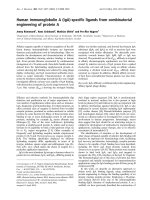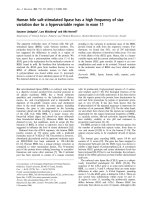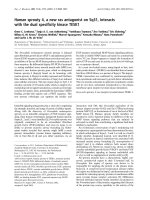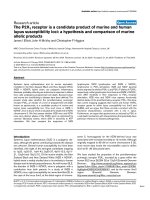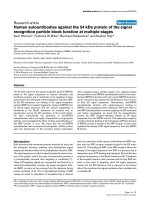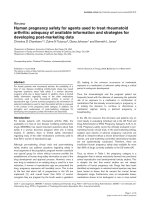Báo cáo y học: "Human genome research enters a new phase" docx
Bạn đang xem bản rút gọn của tài liệu. Xem và tải ngay bản đầy đủ của tài liệu tại đây (45.85 KB, 2 trang )
Genome Biology 2005, 6:337
comment
reviews
reports
deposited research
interactions
information
refereed research
Meeting report
Human genome research enters a new phase
Harukazu Suzuki and Yoshihide Hayashizaki
Address: Laboratory for Genome Exploration Research Group, RIKEN Genomic Sciences Center (GSC), Yokohama 230-0045, Japan.
Correspondence: Yoshihide Hayashizaki. E-mail:
Published: 29 July 2005
Genome Biology 2005, 6:337 (doi:10.1186/gb-2005-6-8-337)
The electronic version of this article is the complete one and can be
found online at />© 2005 BioMed Central Ltd
A report on HGM2005, the tenth annual Human Genome
Meeting, Kyoto, Japan, 18-21 April 2005.
The Human Genome Meeting (HGM) is an annual event
organized by the Human Genome Organization (HUGO) for
scientists working on the human genome. This year’s HGM
was the tenth anniversary meeting, with approximately 500
presentations covering a wide variety of work on the human
genome. In his opening remarks, the president of HUGO,
Yoshiyuki Sakaki (RIKEN Genomic Sciences Center, Yoko-
hama, Japan), commented that participants would have
plenty of opportunities to find out “what is going on in the
post (human) genome sequencing era”. This report discusses
a few of the latest research findings that were presented at
the meeting.
It is clear that large-scale sequencing facilities are still
important, and indeed essential, for genome science.
Richard Gibbs (Baylor College of Medicine, Houston, USA)
reported that the genome sequencing projects of many
animal species, including the Rhesus macaque, orangutan,
Tammar wallaby, cow, and the honeybee, are ongoing and
will soon provide us with valuable resources for the analysis
of these organisms and for comparative genomics. He also
reported that the phase I plan of the human HapMap
project, in which common single-nucleotide polymorphisms
(SNPs) are covered at a resolution of 5 kilobases (kb), has
now been completed.
The completion of the human genome sequence and the
progress of the HapMap project have facilitated genetic
approaches to disease-associated genes and regions. Kari
Stefansson (deCODE Genetics, Reykjavik, Iceland)
described the genetics of complex traits in the Icelandic pop-
ulation: among more than 50 ongoing projects, 30 are
focused on the mapping of disease-associated loci, 15 on
gene isolation and eight on drug development. He reported
that LTA4 hydrolase, an enzyme involved in leukotriene B4
biosynthesis, is associated with myocardial infarction (MI),
and that LTB4 upregulation by ionomycin stimulation of
neutrophils is higher in MI patients than in healthy people.
The deCODE team has recently developed a drug, DG-031,
which acts as an inhibitor of LTA4 hydrolase.
Leena Peltonen (National Public Health Institute, Helsinki,
Finland) showed that isolated populations, like that in
Finland, are ideal for mapping and cloning disease genes
because of the low level of genetic and environmental varia-
tion between individuals. She also reported a successful
example of this mapping, showing that the gene encoding
upstream transcription factor 1 (USF1) is associated with
familial combined hyperlipidemia.
Once genomes have been sequenced, the most important
follow-ups are large-scale projects for analyzing the function
of the genome. Despite our knowledge of the sequences of
the genome and the transcriptome (the genes transcribed
into RNA), we still know comparatively little about the func-
tion of many of the genes, which requires further research.
Anindya Dutta (University of Virginia, Charlottesville, USA)
introduced an overview plan of the ENCODE (Encyclopedia
of DNA elements) project. The initial stage of the project,
now under way, involves using a variety of techniques to
investigate 44 selected human genomic regions, correspond-
ing to 1% of the genome. Dutta described his studies profil-
ing the replication of DNA within chromosomes 21 and 22
and of the ENCODE regions. The results from these studies
using HeLa cells demonstrated that 440 regions (56% of the
examined sequence) showed replication in either early (0 to
4 hours) or late (6 to 10 hours) S phase, and the remaining
44% of the region was replicated throughout S phase. Early
replication was correlated with regions of high gene density,
a result consistent with ENCODE data showing that the
early-replicating regions are rich in transcripts and contain a
higher density of DNase I hypersensitive sites (an indicator
of transcribable genes).
We described the Genome Network, a project led by Japanese
researchers that aims to use genome structural data such as
genome and transcript sequences to create experimental
resources for genome-wide functional analysis of components
such as expression regulatory regions and protein-protein
interactions. These datasets will eventually be integrated in
order to systematically explore the pathways connecting
genes to the organism’s phenotype at the molecular level. One
of us (Y.H.) also discussed the high complexity of the tran-
scriptome, the existence of many non-coding RNAs, and the
importance of natural antisense transcripts. The functional
significance of the sense-antisense relationship of transcripts
was also discussed by Dvir Dahary (Compugen, Tel Aviv,
Israel), using a comparative analysis of the genomic organiza-
tion of genes between human and Fugu.
In the symposium on comparative genomics Svante Pääbo
(Max Planck Institute for Evolutionary Anthropology,
Leipzig, Germany) described a comparison of the expression
level of 12,000 transcripts between human and chimpanzee,
looking at various different tissues. He reported that approx-
imately 10% of transcripts showed differences in their
expression level in the brain in the two species, and that the
divergence of gene expression between the brain tissue of
humans and chimps was smaller than that in the liver and
testis. He also suggested that a change in expression is under
positive selection for some genes, although the evolution of
gene expression is generally neutral and occurs at a constant
rate. Eddy Rubin (DOE Joint Genome Institute, Walnut
Creek, USA) discussed the extraction of non-coding (non-
open reading frame) elements on human chromosome 16
that are highly conserved between human and Fugu and
which may regulate downstream genes, and the characteri-
zation of these elements using a transgenic mouse reporter
assay. He stressed the importance of computational model-
ing using a gene-regulatory ‘training set’ in order to under-
stand more about the rules of gene-regulatory mechanisms
and sequences underlying tissue-specific gene expression,
and to identify significant DNA motifs that are involved.
Two particularly interesting technological developments were
reported. Simon Bennett (Solexa, Little Chesterford, UK)
described the company’s novel ‘single-molecule-based
sequencing technology’, which simultaneously reads 25 bases
of each of 10 to 20 million fragments of an individual’s
genomic DNA. The sequencing is carried out by 25 cycles of a
one-base extension reaction of fluorescently labeled
nucleotides on the genomic DNA fragments, which are
attached to a solid surface to form a ‘single molecule array’.
The method is reported to be between 100 to 1,000 times
more efficient and cost-effective than conventional sequenc-
ing technology and will be available at the beginning of 2006.
Kunihisa Nagino (Toray Industries, Kamakura, Japan)
reported a novel DNA microarray chip technology that
achieves a level of sensitivity up to 100 times higher than con-
ventional DNA microarrays, with an extremely high signal-
to-noise ratio. This technology is still new but the rapid
development of a practical DNA microarray chip, together
with the appropriate software, would be of great benefit to
researchers working on genome sequencing and analysis.
This year’s meeting was a stimulating and interesting oppor-
tunity to share information and results with researchers in
both academia and industry, and it is hoped that the HGM
will continue to initiate collaborations and ideas that will
promote great progress in genome research.
337.2 Genome Biology 2005, Volume 6, Issue 8, Article 337 Suzuki and Hayashizaki
Genome Biology 2005, 6:337

